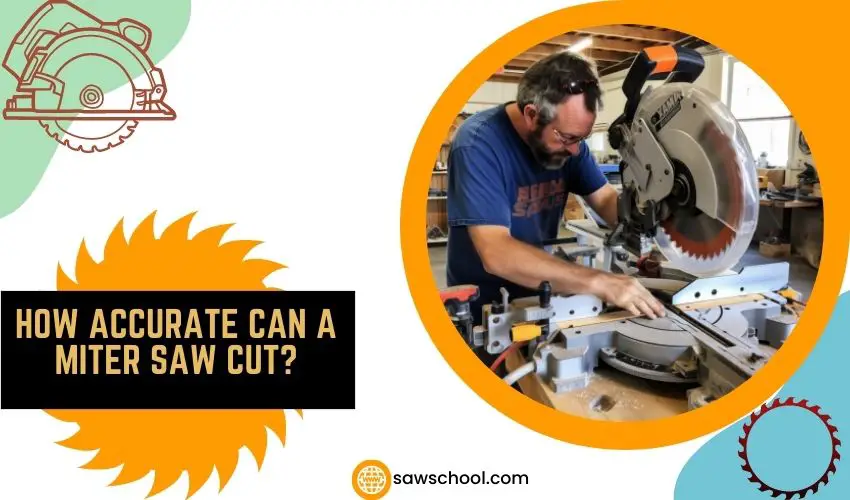Miter saws can offer diversity when it comes to woodworking. While some projects like framing do not require meticulous measurement accuracies, others do. That’s when the obvious question pops up. How accurate can a miter saw cut?
The accuracy widely depends on the miter saw you are using and how effectively you’re using it. There are several techniques that you can use to make your miter saw more accurate.
If you are confused about how the accuracy can fluctuate, make sure to read the entire article to get a better insight into the issue.

How Accurate Can A Miter Saw Cut?
Regardless of the advertisements from different brands, accuracy is not a fixed thing that you can expect from your miter saw. It’s something that can increase and decrease depending on several factors. The first thing that matters is the miter saw you’re using.
Not all miter saws are capable of being extremely accurate. That’s why it’s important that you take your time when researching the miter saw you’re going to buy. The next thing that matters in determining your miter saw is your experience level.
You will certainly notice a significant amount of change in the accuracy level of your miter saw with time. The reason is that you get better at using the unit with time. So, the more precisely you can utilize your miter saw, the more accurate cuts you can expect.
How To Make Your Miter Saw More Accurate?
The good news is that you can tweak a few things to make your miter saw more accurate. Let’s take a look at the things that you can alter to ensure better accuracy when cutting materials.
Proper Tools For Calibration
When you’re calibrating your miter saw, the tools you’re using are extremely important. No matter how small the tool is, it has to be accurate if you want to make your miter saw more accurate.
So, do not try to save money on these tools that ensure your miter saw’s accuracy. Whether it’s a dial indicator or a combination square, invest in the right tool. As long as you calibrate your miter saw using accurate tools, you can get more accurate cuts using the same miter saw.
If you are new to using a miter saw and have no idea how you can calibrate your miter saw, here is an article from Pro Tool Reviews. You would be surprised to know how much difference it can make once you check all those little details.
High-Quality Blade
One of the most important things in your miter saw that’s responsible for accuracy is the blade. First of all, you must use the proper blade when cutting a specific blade. That makes a huge difference in the outcome.
Secondly, if you are trying to increase accuracy, you should look out for the blade’s kerf. The kerf basically refers to how wide your blade is. If your blade is thinner, it will go through the material by minimally losing the surface. However, the minimum width is essential to ensure that the blade is sturdy enough to last long.
Investing in a high-quality blade ensures that the blade lasts long and loses a low amount of surface area. It can have a noticeable change in the accuracy level. Moreover, make sure that the blade is as even through its entire surface as possible. The better you can decrease miter saw runout, the better.
Good-Quality Miter Saw
The miter saw itself has to be accurate enough for other aspects to work well. No matter how carefully you measure everything, if the miter saw is not created accurately enough, you cannot get preciseness from the unit.
Sometimes, the blade that comes with the miter saw is not as high-quality as the miter saw. In these cases, changing the blade to a new one will be enough. However, if you have invested in a DIY miter saw, you cannot expect industry-level accuracy from the unit.
That’s why it’s essential to set your expectations and create the budget accordingly. When you have the right unit at your hand, you can do your best with other aspects to bring the best out of your miter saw.
Setting The Parameters Correctly
Understanding your miter saw is one of the most important things. Get through all types of measurement requirements for the project you’re doing and then match those measurements with your miter saw.
When you’re using a DIY miter saw, you may not have to worry about so many parameters. But if you’re using, let’s say, a sliding miter saw, then you need to set all the components in place. That includes the bevel, the base, and the head.
For beginners, things like cheat sheets can help determine specific measurements. For instance, when you’re cutting crown moldings using your sliding miter saw, the stop at 31.6 degrees can result in perfect 45/45 crown moldings. You can read more about it in my article on why does my miter saw have a stop at 31.6 degrees.
This is just one example of how important it is to determine the appropriate measurements for accuracy. So, make sure that you have all information at hand before getting started with your project.
Practice
As I have mentioned before, the accuracy of the cut depends a lot on the user. The more you use your miter saw, the more accurate your cuts will get. After ensuring a high-quality miter saw, the perfect blade, and calibrating your miter saw, the rest falls on you.
The more carefully and effortlessly you can operate your miter saw, the better your cuts are going to get. Experience is a large factor here. So, you have to put in enough hours to get more accurate with your miter saw.
Some Tips To Remember

- The surface that you are placing your miter saw on must be even. An uneven surface can interfere with the accuracy of your miter saw.
- For materials like PVC, MDF, etc., use a blade with a high tooth count.
- For rip-cutting hardwood, use a blade that comes with a low tooth count.
- A clean blade is one of the mandatory requirements for accurate cuts. Clean your blade and your miter saw as frequently as necessary.
- If your blade is bent or missing teeth, it will not give you clean cuts. So, replace your blade whenever required.
- Getting a zero clearance kerf plate can also help improve the accuracy of your miter saw.
- The fence must be in the appropriate position with your blade if you want the cut to be clean and perfect.
Frequently Asked Questions

Is it worth buying a miter saw?
If you have second thoughts about investing in a miter saw, some facts can help. The advantages of a miter saw are affordability, less risk, and more preciseness compared to a table saw. Besides, using a miter saw is comparatively easier, making it a perfect option for beginners.
For experts, the miter saw can offer diversity for a busy workshop. Nonetheless, there are a few disadvantages. If you are willing to use the full potential a miter saw can offer, you will have to invest in a high-end miter saw. DIY miter saws won’t be able to offer all the features.
How many teeth are best for a miter saw blade?
The appropriate number of teeth on your miter saw blade depends on the material you are cutting. Both low-tooth count blades and high-tooth count blades come with their pros and cons.
If you are cutting hardwood and do not need a clean cut, a low tooth count will do the trick. On the contrary, for clean cuts on difficult materials, you will certainly need a blade that comes with a higher tooth count.
Final Remarks
When asking how accurate can a miter saw cut, you have to consider a lot of things. But because you can make your miter saw more accurate by tweaking the settings and practicing is what makes the unit more versatile.
Nonetheless, it’s also essential to adjust your expectations according to the miter saw model you have. Not all units come with the same capabilities. Alternatively, you can always invest in a better miter saw that comes with better accuracy. The rest entirely depends on how well you can utilize your miter saw without making errors.
